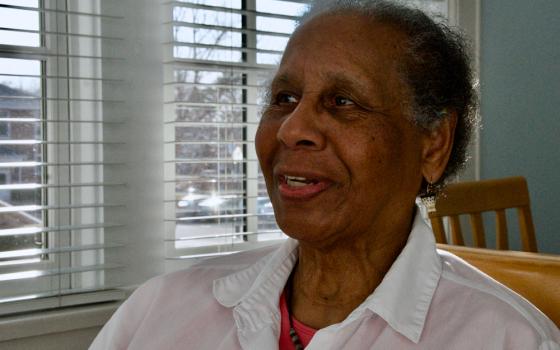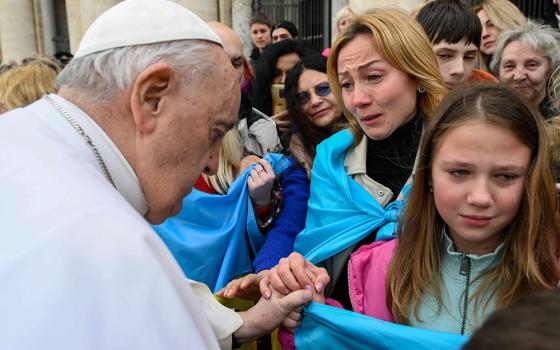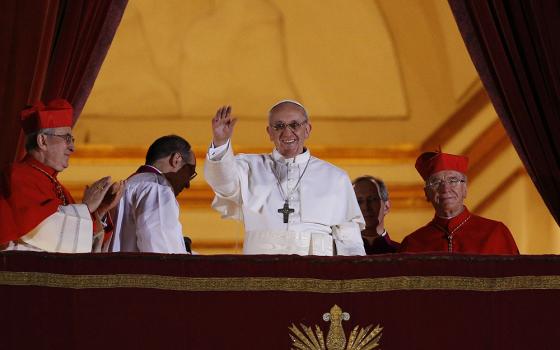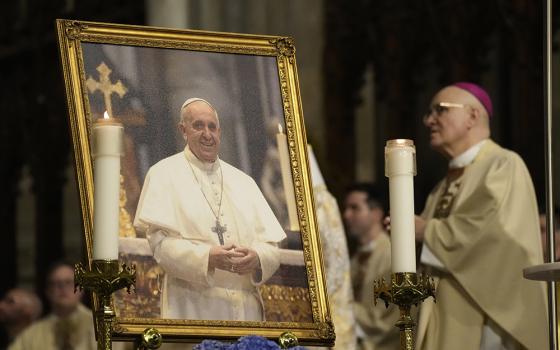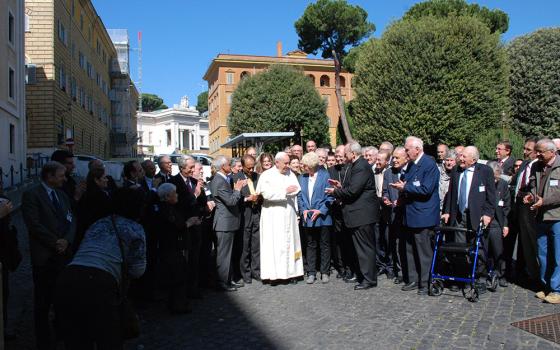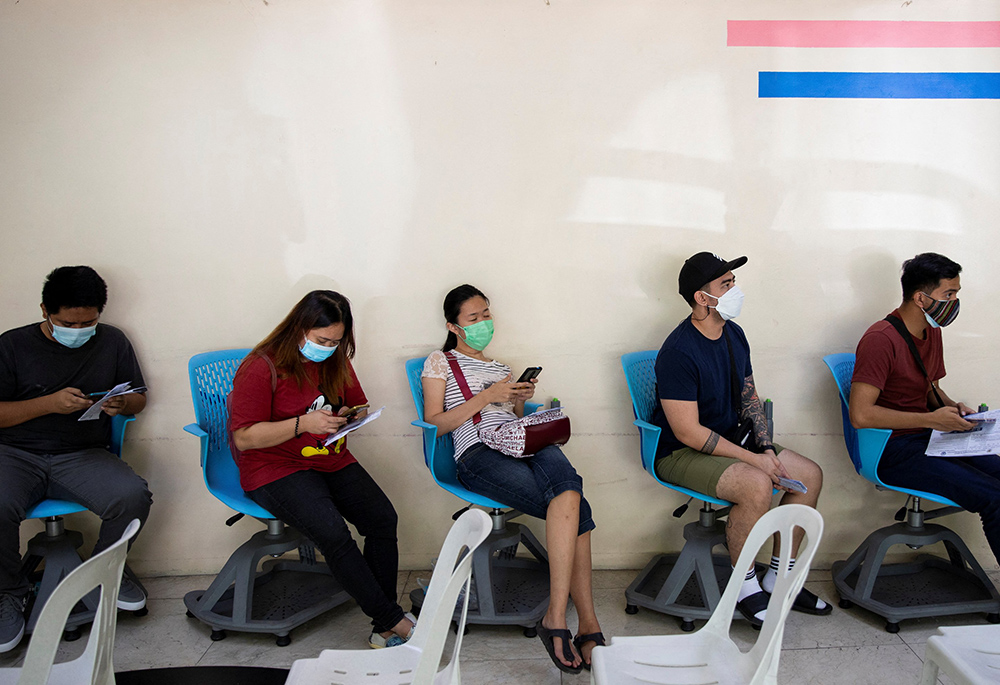
People wait for a booster dose of the COVID-19 vaccine in Manila, Philippines, on Jan. 5. (CNS/Reuters/Eloisa Lopez)
The global COVID-19 pandemic has proven frustrating, durable, confounding and even elusive in its third year.
"Truly, we don't understand this disease well yet," said Sr. Carol Keehan of the Daughters of Charity of St. Vincent de Paul, who heads a health task force for the Vatican COVID-19 Commission.
"We know a lot more than we knew two years ago. But if you look at the way the disease has spread, the way it has mutated, there are more questions than answers," Keehan, the former director of the Catholic Health Association of the United States, told Global Sisters Report.

Durstyne "Dusty" Farnan (Courtesy of Durstyne Farnan)
Despite improved vaccination rates and fewer COVID-19-related deaths in many parts of the world, uncertainty remains, which is why vigilance and a commitment to higher vaccination rates everywhere are needed, said Adrian Dominican Sr. Durstyne "Dusty" Farnan, the U.N. representative for the Dominican Leadership Conference.
"We still can't let down our guard. Cases are up again in some cities in the U.S., and there's a new strain that we're worried about," Farnan said. "There's still a lot that we don't know."
Underlining those concerns are the continuing challenges and changes with the pandemic itself as well as continued inequalities in getting vaccines to people globally.
Addressing a recent summit on vaccine inequality, United Nations Secretary-General António Guterres noted that while some wealthier countries are already providing second booster shots, a third of the world's population still does not have a first dose, UN News reported.
Guterres said the April 8 summit was "a critical reminder that the COVID-19 pandemic is far from over. We're seeing 1.5 million new cases each day."
There have been substantial gains in global vaccination rates in the last half of 2021 and early 2022 — the rate now stands at almost 60% fully vaccinated — with real accomplishments to note.
The fact that India, which the delta variant hit severely in 2021, has fully vaccinated 61% of its population is a "very important landmark," Keehan said, because India "is such a large population, and so many of their population are so incredibly poor."
Yet mixed with those successes is continued hesitancy and even opposition to vaccinations that continues to hobble response to the pandemic, even in the United States.
The continued politicization of the vaccine in the United States continues to concern Keehan and other experts, who point out that while the United States is one of the world's wealthiest countries and has immediate access to the COVID-19 vaccines, the U.S. has substantially lower vaccination rates than many countries in Europe.
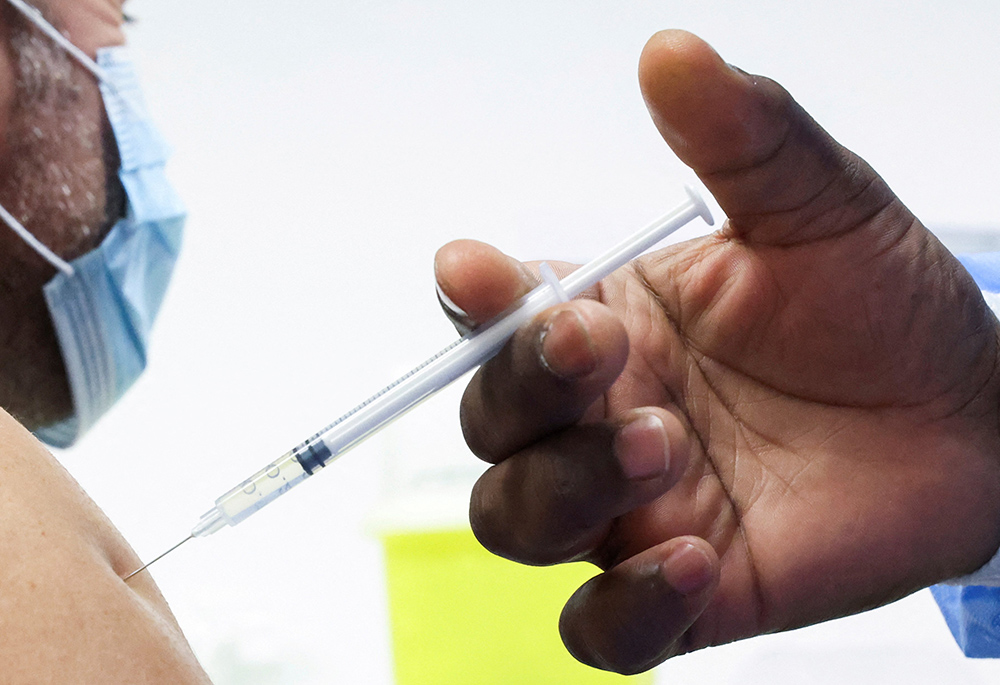
A man receives a booster dose of Pfizer's COVID-19 vaccine in this undated photo. (CNS/Reuters/Yves Herman)
As of April 10, nearly 78% of Americans had received at least one dose of the vaccine, but only 66% had been fully vaccinated. In comparison, 80% of Italians had been fully vaccinated by April 11.
Keehan and current Catholic Health Association staff members say the continued politicization of vaccines is frustrating, though they are proud of the efforts the Catholic Church — from the Vatican down to local parishes — have made globally in getting people vaccinated, including churchwide distribution of vaccination information.
Still, low vaccination rates remain worrisome, especially in Africa. While the rates have improved in recent months, as of March, only 15% of Africans had been fully vaccinated.
Religious sisters in Ghana, Kenya, Zambia and Uganda also have initiated campaigns to urge millions of people to get vaccinated against COVID-19 and, in many cases, also administer the vaccines. The Catholic Sisters COVID-19 Vaccine Ambassadors Campaign, which started in March 2021 when the Catholic Sisters Initiative at the Conrad N. Hilton Foundation partnered with the Vatican COVID-19 Commission, has since expanded to other countries, including India, Tanzania and the Democratic Republic of Congo. (The Hilton Foundation is a major funder of Global Sisters Report.)
However, COVID-related death rates as well as rates of infection and hospitalization have remained relatively low continentwide, as reported recently in The New York Times.
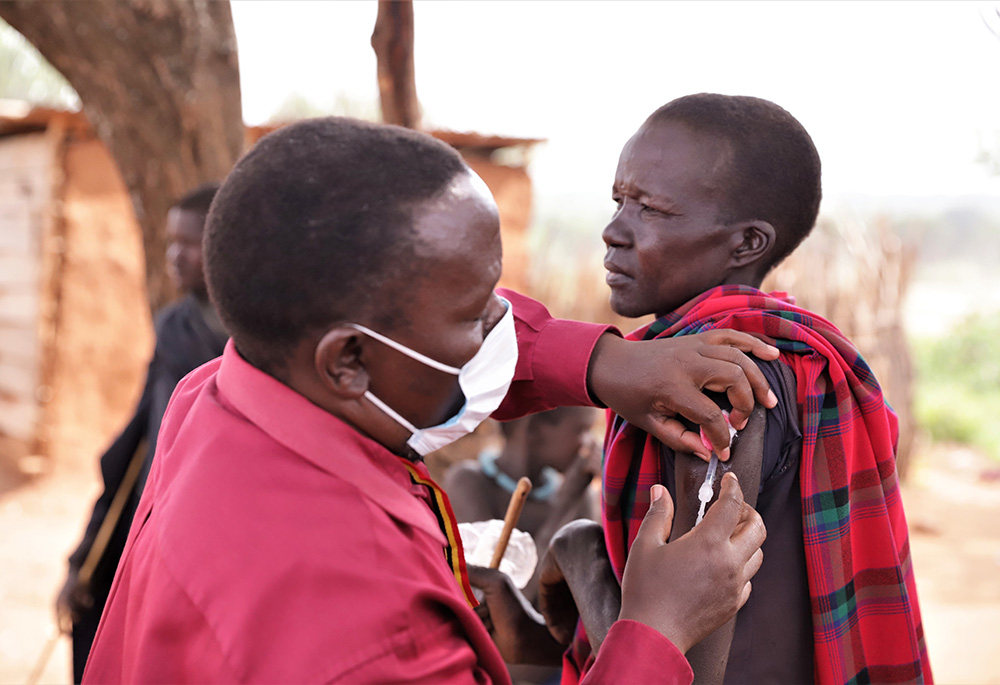
A man receives a COVID-19 vaccine in Karamoja, Uganda, during a February COVID-19 vaccination campaign in rural Uganda. (Courtesy of Catholic Relief Services/Kato Chrysestom)
"I don't think you'll ever know why we have rates that are low, whether it's because our immune systems are fighting off a lot of malaria, typhoid, the things that are very endemic here," said Sr. Barbara Brillant, dean of the Mother Patern College of Health Sciences in the Liberian capital of Monrovia and a Franciscan Missionary of Mary.
Brillant affirmed that in general, rates throughout the continent have improved in recent months; for example, in Liberia, 22% of the population has received at least one shot, according to available data, a substantial improvement from six months ago, when less than 2% had received any dose of the vaccine.
But while that might partly explain the low rates of infection, she said, it still leaves some questions unanswered. Cases could be low because testing is not good enough, she said, or perhaps cases of COVID-19 are not being reported because of often-inadequate medical infrastructure.
"But I think on the average, if people were dying of this thing, we would know it," she said.
Sr. Carol Keehan, a Daughter of Charity and the former president and CEO of the Catholic Health Association (CNS/Courtesy of the Catholic Health Association)
While Africa continues to be plagued with other serious health challenges like malaria, which Keehan said she believes is a greater overall threat to African countries than COVID-19, Keehan and others remain worried.
"My fear is, watching what's happening, that all of a sudden, African countries will have a massive outbreak," she said.
"If it breaks out, we're going to be in a world of hurt."
The pandemic has affected many religious congregations' ministries in African countries. Many introduced strict policies to protect the most vulnerable people, and prayer practices and fellowship also changed. There were forced cancellations of congregational and regional gatherings.
"We have been forced to look for new ways of doing our work, like working and worshipping online," said Sr. Juliana Chibaula Zulu, a member of the Good Shepherd Sisters of Chipata in Zambia. "The deaths of sisters in different congregations really shook us. Nowadays, there are still many complacencies while people are still dying, which is very unfortunate."
Despite these ongoing concerns, as well as continuing problems with shortages of the vaccine, the declining numbers of COVID-19 infections have led many countries to reduce their COVID-19 surveillance and safety measures. Some countries have reopened their economies and resumed social life.
"Nowadays, there are still many complacencies while people are still dying, which is very unfortunate."
—Sr. Juliana Chibaula Zulu
For example, Brillant said at the beginning of the pandemic, Liberians were mindful of the past experience with Ebola and took precautions, including intensive handwashing. But while mask-wearing continues in schools, "I can honestly tell you that out on the streets, nobody's wearing masks."
Even with such realities, "our fight against the virus is still on. We are not stopping anytime soon," said Sr. Nkhensani Shibambu, the superior general of the Companions of St. Angela in South Africa. "We are in this together, and our hope is to one day have a world free of COVID."
Some normalcy returns to Latin America
After accounting for a third of the world's COVID-19-related deaths despite containing just 8% of the global population, Latin America is approaching herd immunity, as most countries have vaccinated more than 60% of its population.
Sr. María Engracia Robles, a Missionary Sister of the Eucharist in Nogales, Sonora, Mexico, told GSR that Mexico appears to "have the green light" when it comes to going back to normal. At the Kino Border Initiative, where Robles is the education coordinator, "we may detect one or two cases among migrants, but for the most part, people seem to be at ease.
"There's a general sense of calm when it comes to the virus."
Despite trends indicating recovery in the region, the Pan American Health Organization warns against complacency.
"COVID-19 infections and deaths are declining in most of our region, but there are still too many cases and deaths being reported every day — a clear indication that transmission is not yet under control," Jarbas Barbosa da Silva Jr., assistant director of the Pan American Health Organization, said in a March 16 press conference.
The real challenge for the region, however, is contending with the socioeconomic impacts of the two-year pandemic: According to a regional survey by UNICEF and IMPACT Initiatives, in 11 Latin American countries and the Eastern Caribbean, nearly half the households with children have enough savings to cover two weeks' worth of basic needs, while roughly 1 in 8 families have enough money to make it just one day at a time.
"The livelihoods of almost half of the region's families with children are hanging by a thread," Jean Gough, UNICEF regional director for Latin America and the Caribbean, said in a press release. "They live day to day in survival mode and can't afford to make plans beyond the next two weeks. Without support, more children and their families will fall further into poverty, and our societies and economies will pay the price for years to come."

Residents in a poor section of Rio de Janeiro receive food and bread produced at the Sanctuary of Our Lady of Fatima during the COVID-19 pandemic. Volunteers delivered the bread June 24, 2021. (CNS/Reuters/Ricardo Moraes)
In the United States, disparities along racial lines
From the beginning of the pandemic, health officials in the United States knew that racial and ethnic minorities and people in poverty would be more at risk of contracting COVID-19, less likely to find adequate treatment for the infection, and more difficult to vaccinate against the virus, said Brian Kane, senior director of ethics at the Catholic Health Association. There was a concerted effort to address those disparities, he added.
Those efforts have had mixed results: According to a report by the Black Coalition Against COVID, vaccination rates for Black and white adults are now comparable, at 80% and 83% fully vaccinated, respectively, despite an initial gap in rates.
However, even though vaccination rates are high, the report showed Black Americans in January had the highest rate of hospitalization of any racial or ethnic group since the pandemic began, likely because of lagging rates of booster shots and vaccinations among children and adolescents.
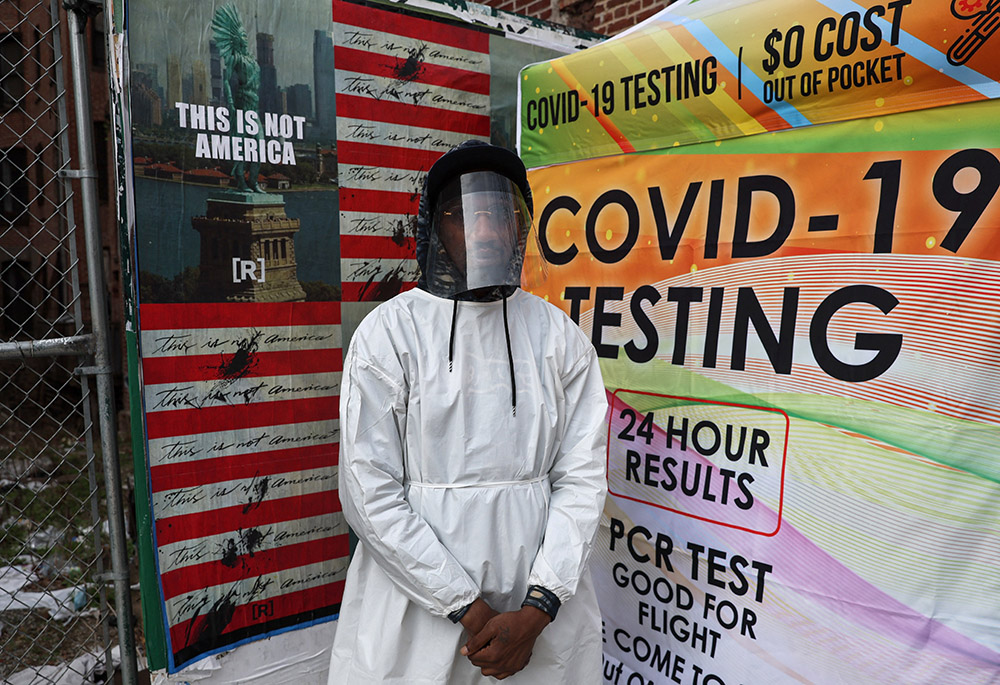
A health care worker in New York City stands for a photograph by a mobile COVID-19 testing center April 4. (CNS/Reuters/Shannon Stapleton)
"What they're reporting is what we know," Kane said. "The statistics are just depressing."
Kane said there is an understandable lack of trust among many communities when it comes to health care, but that can be countered by having the message spread by people within those communities.
"That's essential," he said. "It's about personal relationships. It's about trust."
Building that trust has been a focus of the Catholic Cares Coalition, a coalition of 65 groups and agencies that administers microgrants to promote vaccine acceptance in vulnerable communities. The coalition is funded by grants from the Hilton Foundation and Kaiser Permanente.
Advertisement
Donald McCrabb, executive director of the U.S. Catholic Mission Association, heads up the coalition and noted that with only 66% of Americans fully vaccinated, "we're doing about a D-plus. When we started this, the goal was 90%."
And efforts could get even more difficult: McCrabb said the federal funding that has made vaccines free for Americans is running out.
"If that happens, the hesitancy will be solidified," he said.
In the midst of these challenges, many U.S. communities are lifting restrictions despite new increases in COVID-19 infections and the ongoing concerns about vaccination rates.

Mercy Sr. Mary Haddad, president of the Catholic Health Association (Courtesy of CHA)
"We can't let up," said Mercy Sr. Mary Haddad, president of the Catholic Health Association. "People think this is over and that it's back to normal. There is no normal now."
The pandemic still poses serious challenges to the U.S. health care system, Haddad said: Her most pressing worry is the shortage of health care workers.
"Other medical needs didn't stop in the wake of COVID," she said. "If we don't have appropriate staffing levels, we'll be faced with having to close down institutions."
Another hurdle, one facing populations globally, is that the world doesn't seem focused on the pandemic the way it was a year ago.
Farnan attributes that to a number of factors. Among them: "A lot of focus for many people now is Ukraine, " she said.
But vigilance and a continued commitment to getting as many people in the world vaccinated as possible is still needed, she said.
"We have to remember there are still people in the world who are not vaccinated, who are begging for this vaccine, and so, we have an obligation to them."
[Contributing to this report are Doreen Ajiambo, GSR Africa/Middle East correspondent; Soli Salgado, GSR Latin American correspondent; and Dan Stockman, GSR national correspondent.]




